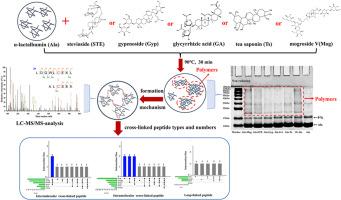探讨植物化学皂苷在阻止α-乳清蛋白热聚集中的作用:多维光谱分析
IF 11
1区 农林科学
Q1 CHEMISTRY, APPLIED
引用次数: 0
摘要
本文研究了茶皂素(Ts)、绞股蓝苷(Gyp)、甜菊苷V (Mog)、甘草酸(GA)和甜菊苷(STE)对热诱导α-乳清蛋白(Ala)聚集的影响,重点研究了二硫交联的抑制机制及其对结构和理化性质的影响。SDS-PAGE和粒径排除色谱(SEC)证实,皂苷可能通过疏水力和氢键结合Ala单体,抑制热诱导Ala (H-Ala)中二硫键的形成,有效减少聚合物的生成,抑制作用顺序为Gyp、GA、Ts、STE、Mog。LC-MS/MS分析表明,Ala(6)、Ala(91)、Ala(111)和Ala(120)是H-Ala中二硫交联反应最活跃的位点。与H-Ala相比,热诱导的Ala-Mog、Ala-STE、Ala-GA、Ala-Ts和Ala-Gyp配合物的分子内二硫交联肽数分别显著减少了5、6、7、8和10个。值得注意的是,热诱导的Ala-Gyp配合物具有最高的绝对zeta电位,最小的粒径和最低的疏水性,这与它具有较好的聚集抑制作用有关。该研究强调了皂苷作为热敏性蛋白质在热加工过程中稳定的天然添加剂的潜力,为食品工业的应用提供了新的见解。本文章由计算机程序翻译,如有差异,请以英文原文为准。

Exploring the role of phytochemical saponins in preventing the thermal aggregation of α-lactalbumin: A multi-dimensional spectrometric analysis
This study investigated how tea saponin (Ts), gypenoside (Gyp), mogroside V (Mog), glycyrrhizic acid (GA) and stevioside (STE) affected the heat-induced aggregates of α-lactalbumin (Ala), focusing on the inhibition mechanisms of disulfide cross-linking and their impact on structural and physicochemical properties. SDS-PAGE and size exclusion chromatography (SEC) confirmed that saponins probably bound Ala monomers via hydrophobic forces and hydrogen bonds, inhibiting the formation of disulfide bonds in heat-induced Ala (H-Ala) and effectively decreasing polymer generation, with the inhibitory effect in the order of Gyp, GA, Ts, STE, Mog. LC-MS/MS analysis revealed that Ala (6), Ala (91), Ala (111) and Ala (120) were the most active sites for the disulfide cross-linking reaction in H-Ala. Specifically, the number of intramolecular disulfide cross-linked peptides of heat-induced Ala-Mog, Ala-STE, Ala-GA, Ala-Ts and Ala-Gyp complexes significantly decreased by 5, 6, 7, 8 and 10, respectively, compared with H-Ala. Notably, the heat-induced Ala-Gyp complex exhibited the highest absolute zeta potential, smallest particle size, and lowest hydrophobicity, which correlated with its superior inhibition of aggregation. The study highlighted the potential of saponins as natural additives for the stabilization of heat-sensitive proteins during thermal processing, offering new insights for food industry applications.
求助全文
通过发布文献求助,成功后即可免费获取论文全文。
去求助
来源期刊

Food Hydrocolloids
工程技术-食品科技
CiteScore
19.90
自引率
14.00%
发文量
871
审稿时长
37 days
期刊介绍:
Food Hydrocolloids publishes original and innovative research focused on the characterization, functional properties, and applications of hydrocolloid materials used in food products. These hydrocolloids, defined as polysaccharides and proteins of commercial importance, are added to control aspects such as texture, stability, rheology, and sensory properties. The research's primary emphasis should be on the hydrocolloids themselves, with thorough descriptions of their source, nature, and physicochemical characteristics. Manuscripts are expected to clearly outline specific aims and objectives, include a fundamental discussion of research findings at the molecular level, and address the significance of the results. Studies on hydrocolloids in complex formulations should concentrate on their overall properties and mechanisms of action, while simple formulation development studies may not be considered for publication.
The main areas of interest are:
-Chemical and physicochemical characterisation
Thermal properties including glass transitions and conformational changes-
Rheological properties including viscosity, viscoelastic properties and gelation behaviour-
The influence on organoleptic properties-
Interfacial properties including stabilisation of dispersions, emulsions and foams-
Film forming properties with application to edible films and active packaging-
Encapsulation and controlled release of active compounds-
The influence on health including their role as dietary fibre-
Manipulation of hydrocolloid structure and functionality through chemical, biochemical and physical processes-
New hydrocolloids and hydrocolloid sources of commercial potential.
The Journal also publishes Review articles that provide an overview of the latest developments in topics of specific interest to researchers in this field of activity.
 求助内容:
求助内容: 应助结果提醒方式:
应助结果提醒方式:


